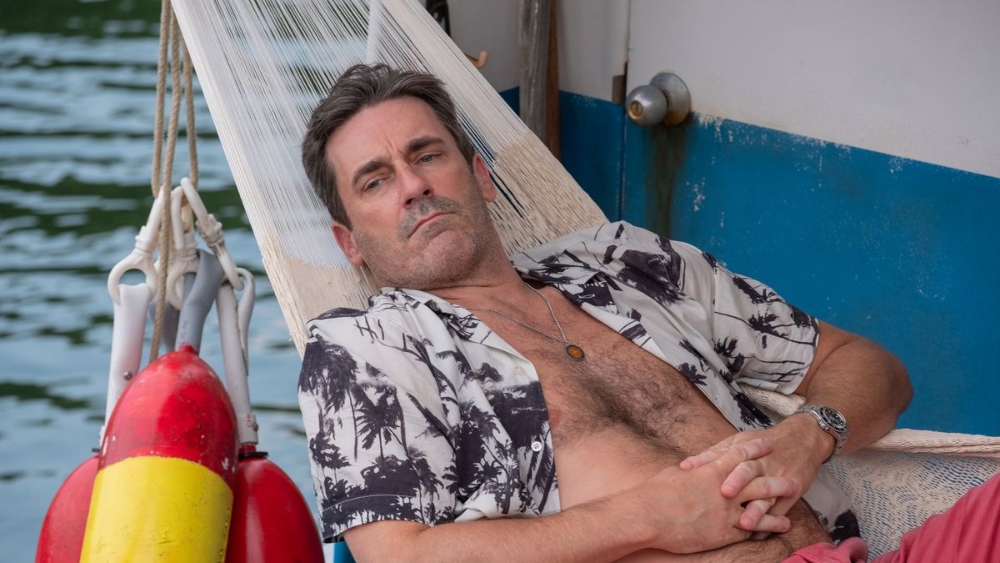
When most film fans list their cinematographers, legends such as Roger Deakins and Emmanuel Lubezki are frequently mentioned, but for me, Sam Levy is among the first who comes to mind, largely thanks to his collaborations with director Noah Baumbach and Greta Gerwig, for whom he shot Frances Ha and Lady Bird.
I’ve become a fan of Levy’s indie work over the years, and his latest feature is Greg Mottola‘s murder mystery Confess, Fletch which stars Jon Hamm as the famed investigative reporter, who is actually the prime suspect in this Miramax movie. Hamm’s Mad Men pal John Slattery co-stars alongside Lorenza Izzo, Roy Wood Jr., Ayden Mayeri, Annie Mumolo, Marcia Gay Harden, and Kyle MacLachlan.
Below the Line recently spoke to Levy, who discussed his visual inspirations for Confess, Fletch as well as the challenges of shooting on the water at night and the glory of filming in Rome.
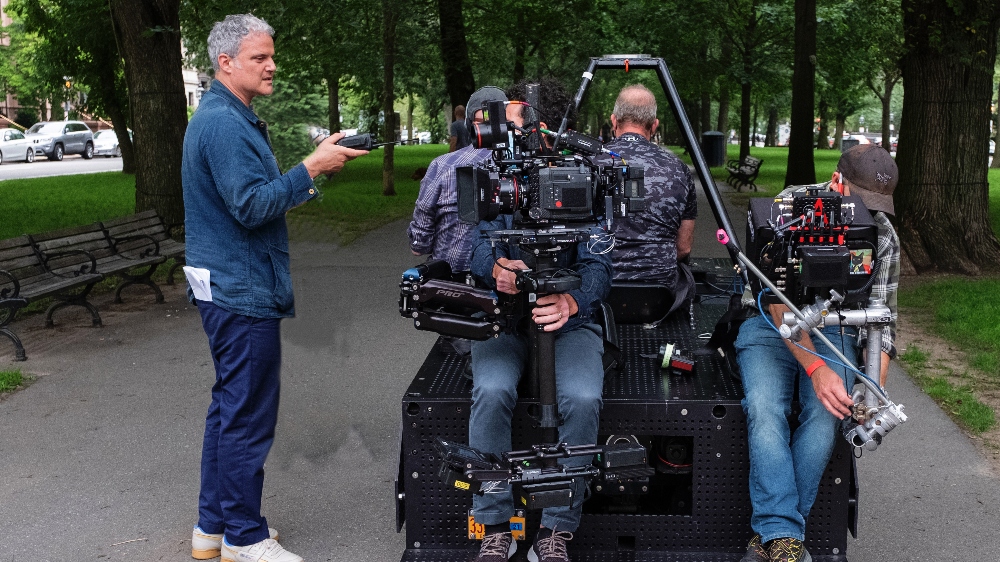
Below the Line: Before we talk Fletch, is there an aspect of cinematography that may give the average film viewer a greater appreciation for the craft?
Sam Levy: I mean, a couple of things come to mind. One is just that, as a cinematographer, you’re really responsible for a massive amount of managerial and logistical situations on a movie [set]. I think the breakdown for me, in my career, is about equal parts photography and artistry, you know — being creative, mixed with economics and working together with producers and the UPM and the assistant directors [to do] scheduling and that kind of thing. I think that what’s probably not commonly understood amongst those who are film enthusiasts but maybe don’t work in the field.
The greatest cinematographers who are admired are usually excellent planners or, I wouldn’t quite say, like, technicians, but just people who are skilled at being managers, you know? It’s managing staffing, managing scheduling, and the time of day. If you’re shooting outside, [you have to] sort of be aware of where the sun will be at different times of day and where it fits in, [which] almost always complicates scheduling. [And] these days [you] have to deal with actors’ schedules. Actors, they’re usually with us, [but] they may have obligations to promote other movies or things like that.
So I think the best cinematographers are just skilled collaborators, not just with the director — that’s probably what’s most commonly discussed; the relationship with the director — but it’s also the relationship with the producers and certainly the other crew who works with and for the cinematographer, like electricians and camera assistants, but also the decorators, construction, even the “Teamsters,” as we call them in the United States — people who drive trucks and vehicles and just transport things. [Maybe] it’s not the most intriguing aspect of cinematography, but it’s vital. If you’re good at that stuff, and especially if you can work fast [and] then your artistry is strong as well, there’s a place for you.
And it was a big thing to discuss on Confess, Fletch — which we’ll discuss — and something like Mayday, which was shot right before Confess, Fletch [because there were] lots and lots of day[time] exteriors to be mindful of [and] ‘when is the ideal time to shoot this type of scene?’ Usually, [it’s] later in the day, before sunset — but you can’t do everything at sunset. So, you know, stuff like that, I knew was important, [even] when I was younger and less experienced, but I just wasn’t as skilled at that particular planning.
Now, it’s become much more intuitive and I can [get an] answer very quickly. iPhones now have, like, SunPass software so you can see exactly where the sun will be three months from today and things like that. But it’s probably best, in a way, that the audience is not aware of a lot of that stuff and ideally, they just lose themselves in the movie or the show or whatever it is they’re watching.
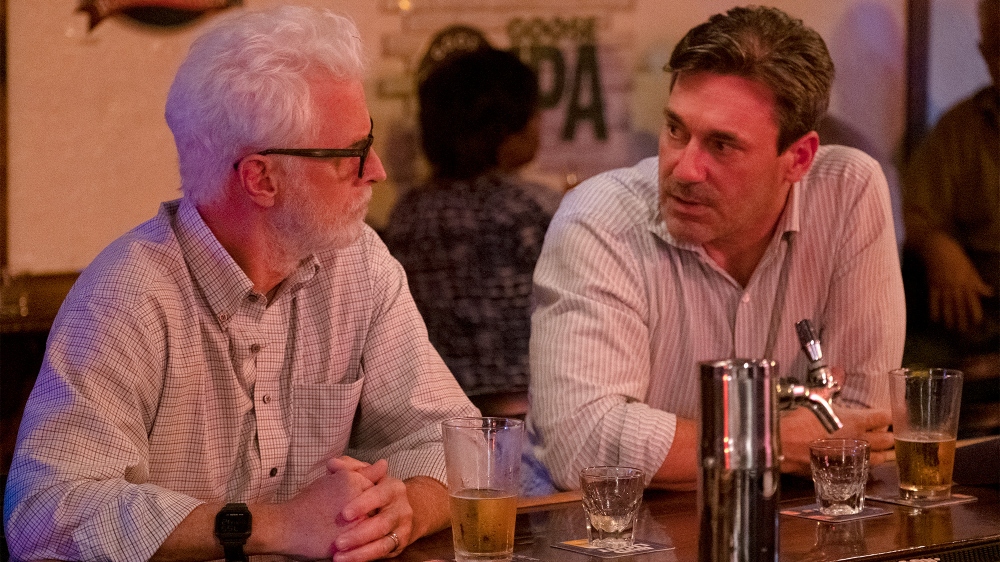
BTL: To follow up on that, because you talked about planning and scheduling, does that mean you’re involved in location scouting as well?
Levy: Yes, location scouting is a big part of cinematography, and ideally, on a movie or long-form project as a DP, we’re director scouting, which means scouting with a director at a point where locations are not locked in. Later we text out with the crew [but] by that point, so much has to have already been decided and we’re just confirming where we’ll be on what day and where we might put lights and that kind of thing. But the best kind of scouting is [done] long before that.
Ideally, nothing’s been chosen and I’m looking with the production designer, the director, [the] location manager [and] producers. Or I go by myself, or with the director a few times to have, what I’d call more sort of “dreamy” conversations and less of all that tactical stuff. That’s important, but I would say it’s great if you can leave all the tactical stuff for later to just kind of determine, creatively and artistically, what’s important in this scene in this movie. What are we trying to do? What’s the creative mission? I want to determine that and [then] it’s pretty clear [that] you can take steps to get at it.
BTL: Let’s transition over to Confess, Fletch. How did you first get involved with the project?
Levy: The short answer is, Alex DiGeriando, the Production Designer, who’s a very good friend. We’ve worked together before. Alex joined the project first and suggested me to the director-writer, Greg Mottola. Alex suggested me, I met with Greg, [and] we instantly clicked. And Greg offered me the job something like 10 minutes after our first meeting. He emailed me and said, ‘I’d love for you to join,’ which is very rare. People usually meet [with] a handful of different people and do [their] due diligence, especially on a studio project, but yeah, Alex paved the way and then we were all off and running.
Thankfully, Alex and Greg did a bit of scouting before I joined and set a bit of a foundation. I was able to get up there soon after and kind of collaborate with Alex, Greg, and Alex’s set decorator, Kendall Anderson, who’s like a great friend. We’ve done other movies, Kendall and I, [which is a] big reason the movie looks the way it does. And there is a lot of very sophisticated design, art, and colors, and we definitely collaborated on that stuff, but because of time restraints, they really had to take it and run. I’m [just] really grateful we got to do it together.
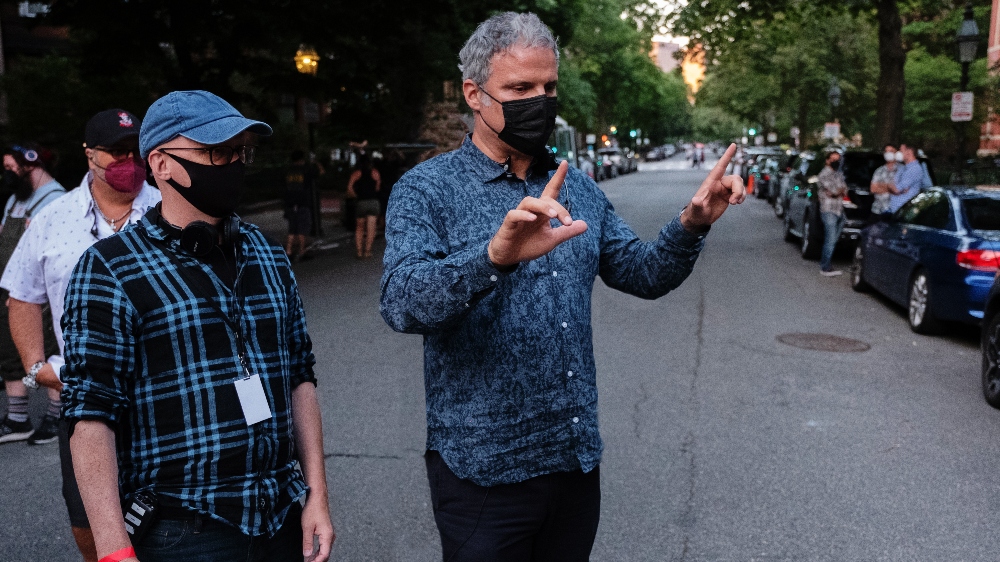
BTL: How long was the shoot?
Levy: Principal photography was about 30 days, I think. Because of COVID reasons — which a lot of people have to contend with — technically, it was a little longer. I think it was like 33 days or something like that, but the [original] plan was 30 in Boston, and then we shot for a handful more days in Rome. Let’s say it was about 35.
BTL: Do you remember those first conversations you had with Greg Mottola? Was there any sort of specific approach that you decided to take on this film?
Levy: Well, the first conversation that I had with Greg Mottola, and what really drew me to wanting to work with him, was [that he] talked a lot about the legendary DP Gordon Willis. Gordon Willis photographed all of The Godfather movies, most of Woody Allen‘s best-known movies like Manhattan and Annie Hall, Klute, The Parallax View, All the President’s Men, [and] a lot of legendary ’70s movies. He is [a] massive inspiration to DPs of my generation and I’ve watched all of his work obsessively since I was a teenager.
So sometimes, people will talk about this great DP and those great movies but it’s often lip service because it’s [a] very notable kind of extreme work that plays a lot with shadow, and he is very influential in sort of reducing the [number] of shots, or “coverage,” [as] we call it — you know, sort of shooting many different angles and figuring out how to edit it later rather than pre-planning and designing a more intricate choreography.
So Greg was talking about Gordon Willis and I [could] tell he really understood what that work was about — that he wasn’t just paying lip service. Greg’s a very brilliant guy and I could just tell he’d really watched and studied those movies and he understood how they were created. So that was one big inspiration, just looking at some of those movies I mentioned.
But then for me, a movie that I really was inspired by for Confess, Fletch was Alfred Hitchcock’s To Catch a Thief with Cary Grant. He plays a jewel thief in the movie so he sneaks around a lot in the dark and he always looks great and he’s wearing this kind of burglar’s costume. Jon Hamm’s the star of this movie [Confess, Fletch], the protagonist, but he’s also the producer and a very talented producer, so I thought, ‘He’s an extremely athletic, beautiful guy,’ and there are a lot of scenes where Fletch sneaks around in the dark [and] is running around planting explosives and stealing paintings. Confess, Fletch is a murder-mystery movie and it has elements of a thriller, but there are [also] some action sequences, which really drew me to this movie. And the more I watched To Catch a Thief, the more I was really inspired [to shoot] Jon as a Cary Grant-type figure.
And so those were the two sort of foundational movies that I was inspired by [and] also, the photography of Christopher Anderson and Marie Cosindas. Marie Cosindas took a lot of Polaroid portraits from the ’70s. Those four things were in the production office. I put frame grabs of those four things on my wall, and those were the primary references and then I would organize these color summit meetings. We called them with Alex, the production designer, Wendy Chuck, the Costume Designer, and Greg. We would just look at all these photos and people would sort of grab [onto] the things that inspired them.
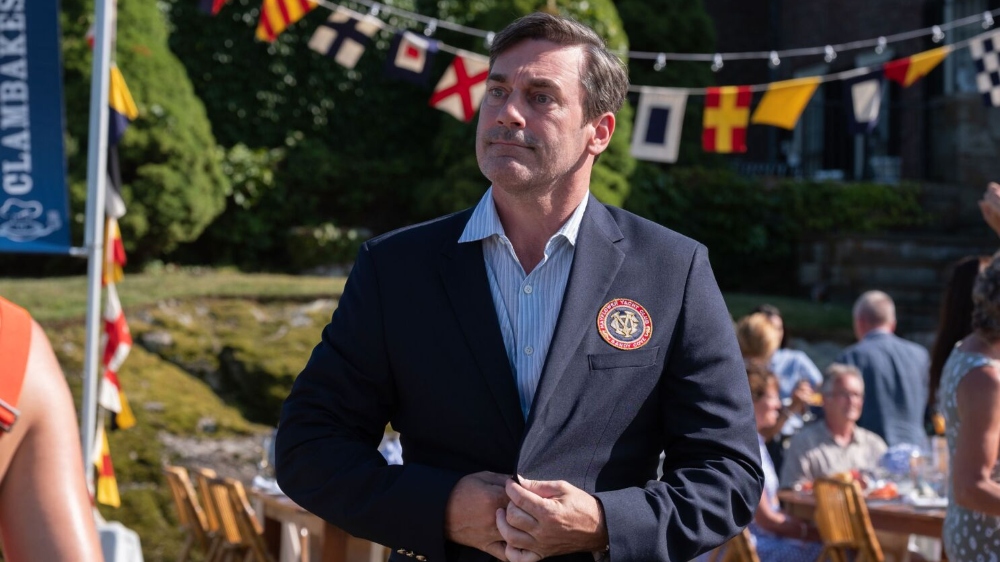
BTL: Were you a fan at all of the original Fletch, and did you refer to that film at all during your research phase?
Levy: We didn’t use it at all, but I was a fan for sure. I mean, when I was a teenager, the original Fletch movie was huge; it was definitely the biggest movie of its time when it came out. Moreover, it was a big “video store rental” movie. Like, everyone would rent Fletch. I mean, [if] you went to the video store to rent a movie on the weekend and you didn’t know what to rent, every now and then you [would] circle back to Fletch because it’s hilarious.
But we honestly didn’t ever look at it. The important thing [about] this new movie is that it’s really inspired by one of the other Fletch novels that [were] written by Gregory McDonald. There’s a series of Fletch novels and Confess, Fletch is the name of one of these novels. So even though, technically, you could say this movie is a “reboot” because there’s another Fletch movie, it’s really not. And everyone probably says that it may not have gotten made if there wasn’t this popular ’80s movie [and] that it’s someone’s IP and that sort of thing.
BTL: Were there any difficulties during the shoot or sequences that were challenging to shoot?
Levy: There were two tricky sequences to shoot. One of them [is] where Jon Hamm is sneaking around a gigantic yacht club at night and planting explosives. From the moment I took this job, I started thinking about and planning the sequence because it takes place over an enormous area on the water at night. Jon Hamm goes on a boat and sneaks onto another boat and breaks in, and then there are explosives that had to be planted. And we had to think about the trajectory of explosives and pointing them at a boat, all that kind of thing. So we really had to work out on the water where the camera had to go on a camera boat, [and where] lights had to go on lighting boats, and that kind of thing. It’s just super intricate.
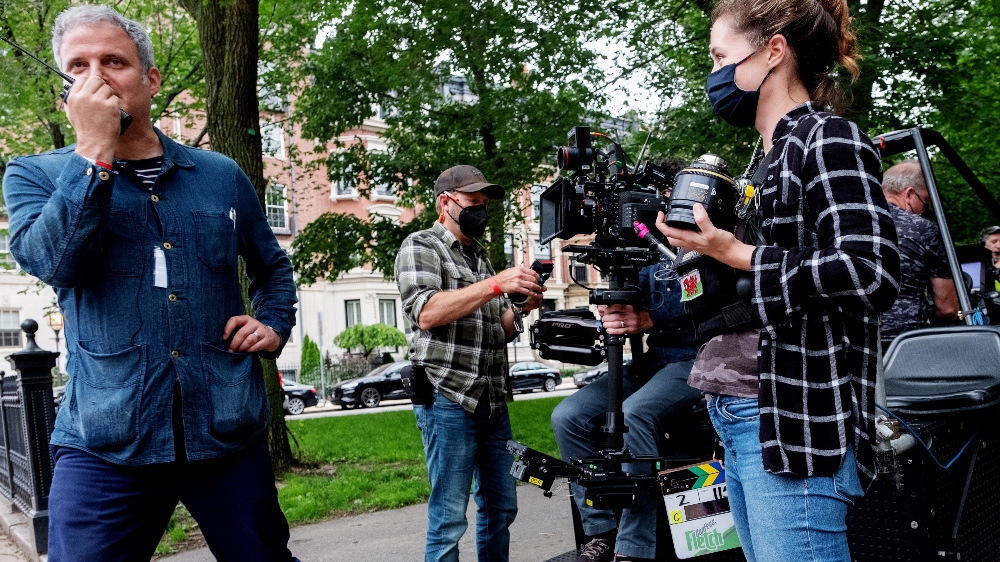
We had a great Marine coordinator who helped us with a lot of that stuff. That was, without question, the hardest thing to shoot, but by the time we got to it, it was straightforward enough. It’s all night exterior work, which is almost always the trickiest thing to film in that you need to light an enormous area, and how do you do it? What’s the lighting motivation?
Because I worked with a local crew in Boston whom I [had] never worked with before, my big question to the gaffer who I hired was, ‘Tell me how you would do this. Diagram it out. I sort of know what I want to do, but I wanted to see what you would do here?’ And he made this beautiful diagram with a million lights all over the place and we really had to devote resources to getting those sequences, and I really admire Greg Mottola for writing that and really sticking to his guns about shooting it certain ways.
He definitely was asked [about it]. We had a very supportive production and studio team, but he was definitely asked, ‘How important is this?’ Because you’re always trying to balance a budget and just see what’s really critical, especially if something’s very costly. But he [didn’t want to] cut that or change it, which is extremely challenging, so it was really rewarding. I love watching all that stuff in the movie.
BTL: Before I let you go, you talked a little bit about the relationship between the cinematographer and director and I know you’ve worked with Noah Baumbach and Greta Gerwig quite a few times, so I’m just curious how your relationship with those two blossomed.
Levy: I was introduced to Noah Baumbach by my mentor, who was the great cinematographer Harris Savides. Harris had shot two movies for Noah — Margot at the Wedding and Greenberg — and Noah first called Harris for Francis Ha because they’d done two movies together. But Harris was not available and so he very generously suggested that we meet. And the three of us met together at Noah’s apartment and we shot a test together of Greta just walking around Noah’s apartment, walking around outside, and just doing this and doing that. And then we made a 35mm print of it and watched it together and then Harris was off.
It was just his way of sort of handing over this movie and the relationship to me. And then several years later, he very sadly passed away [due] to cancer. But anyways, that was how I met Noah; I met Noah and Greta at the same time and we worked on several movies together and then Greta and I did Lady Bird together, which was not with Noah but he was always around and really loving and supportive.
Confess, Fletch is now playing in select theaters and available on VOD. It will premiere on Showtime on Oct. 28.





